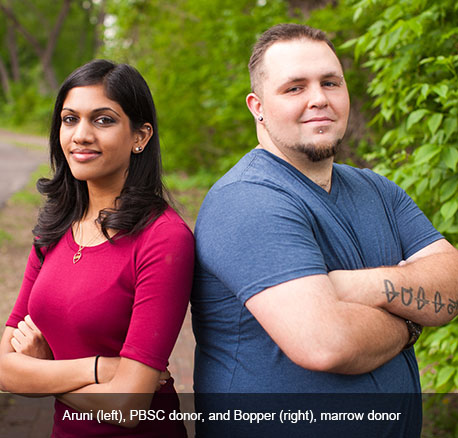Steps of Donation
When someone has been identified as the best match for a patient, they will participate in an information session with their donor center representative where they will learn everything they need to know about donation. If they agree to move forward, they will undergo a physical exam and give blood samples. After these steps are successfully completed, they will proceed to donation.
There are two methods of donation: peripheral blood stem cell (PBSC) donation and marrow donation.
PBSC Donation
PBSC donation is a nonsurgical procedure that takes place at a blood center or outpatient hospital facility. It is a method to collect blood-forming cells (sometimes called blood stem cells) found in circulating (peripheral) blood. These are the same stem cells that are found in marrow. PBSC is collected through a standard apheresis process that requires venous access with a 16 to 18 gauge needle in both arms. PBSC collections are completed in four to eight hours, over a one or two-day session.
PBSC is Studied Under a Protocol with the FDA
The National Marrow Donor Program® (NMDP) is studying the use of PBSC for transplant under a clinical research study reported to the U.S. Food and Drug Administration (FDA).
For five days leading up to donation, donors will be given injections of a drug called filgrastim, also called rhG-CSF and marketed in the United States as Neupogen®. This drug helps increase the number of blood-forming cells in a donor’s bloodstream. PBSC donors can expect to experience a headache or bone or muscle aches for several days before collection, a side effect of the filgrastim injections. These effects resolve shortly after collection. Most PBSC donors report that they feel completely recovered within two weeks of donation.
Marrow Donation
Marrow donation is a 60 to 90-minute surgical outpatient procedure performed under general or regional anesthesia. During the procedure, donors lie prone while marrow is withdrawn from their posterior iliac crest through several small incisions. The average amount of marrow and blood donated is about one quart. If the patient is a child or infant, less marrow is needed.
Marrow donors can expect to feel some soreness in their lower back for a few days or longer following the donation. Most marrow donors report that they feel completely recovered within three weeks of donation.
For more information about the steps of donation, visit NMDP.org

